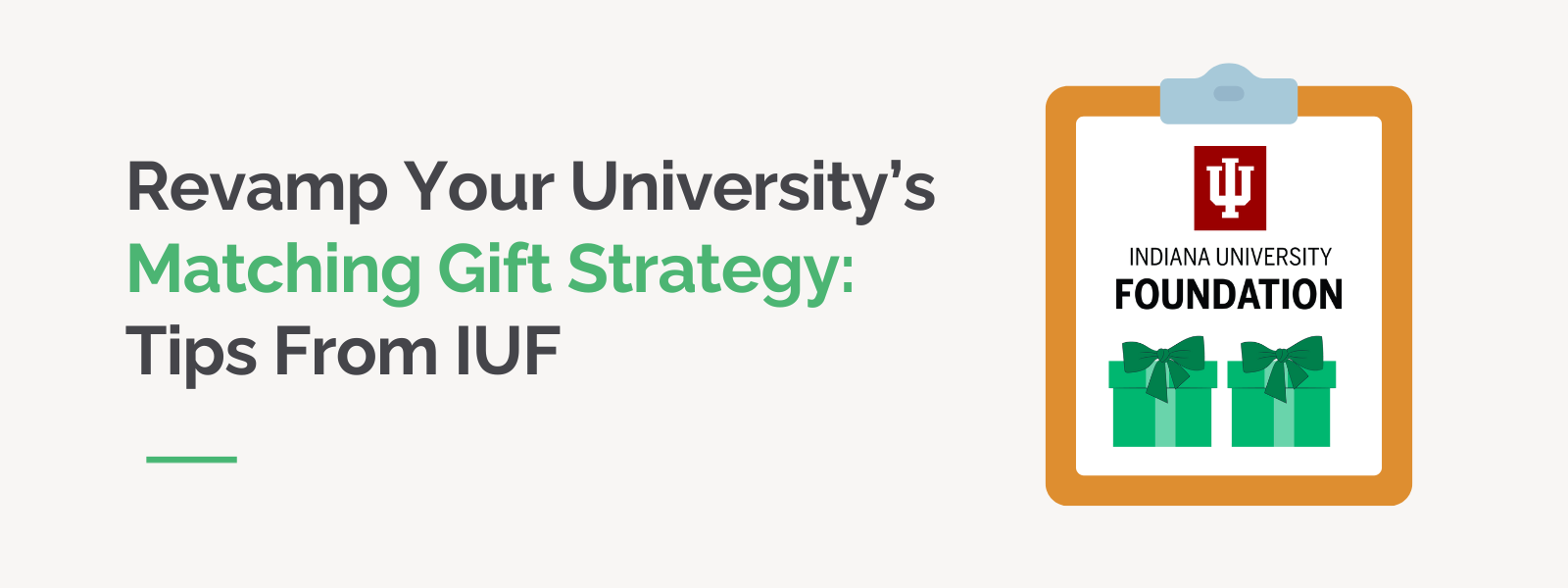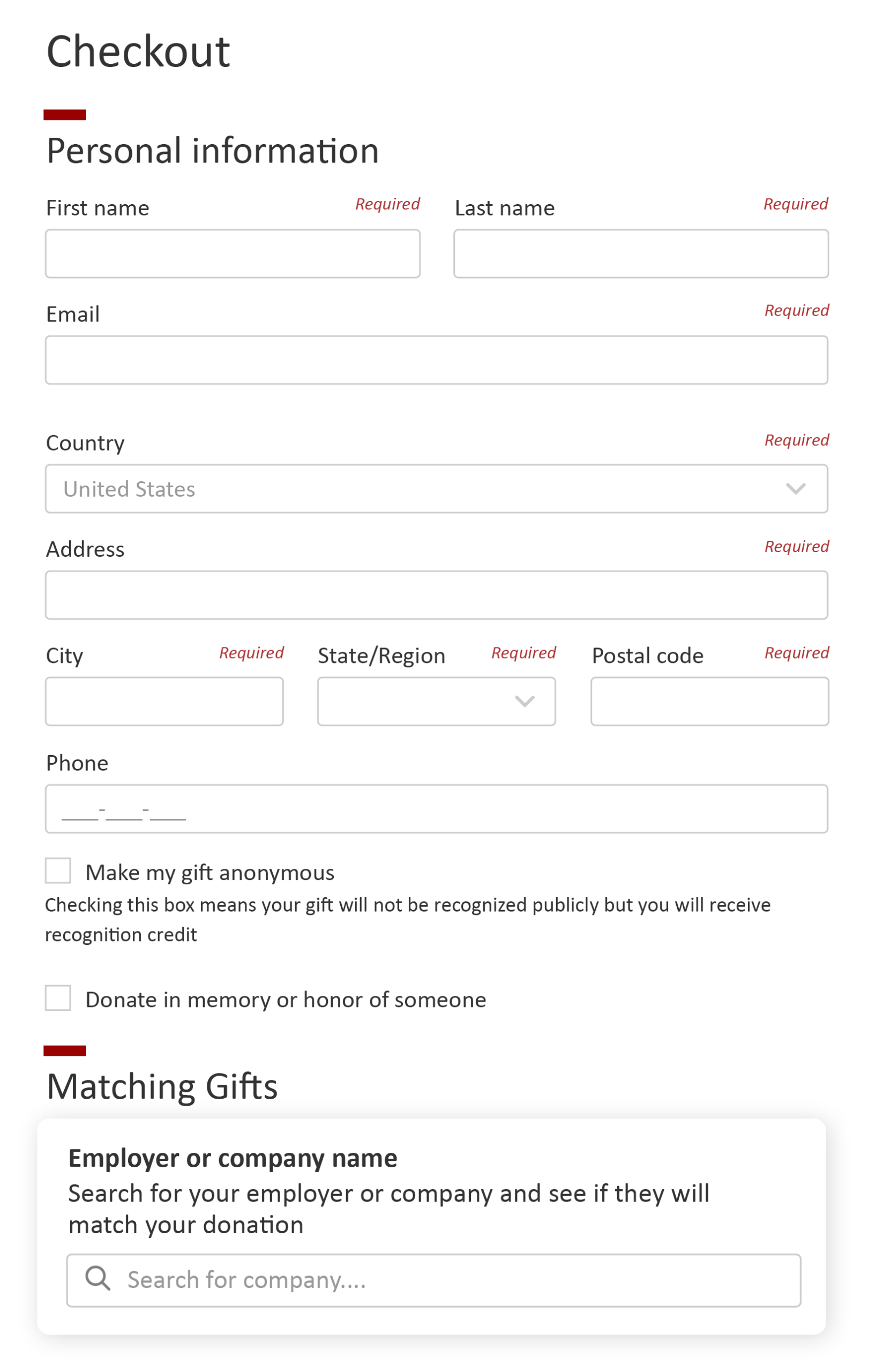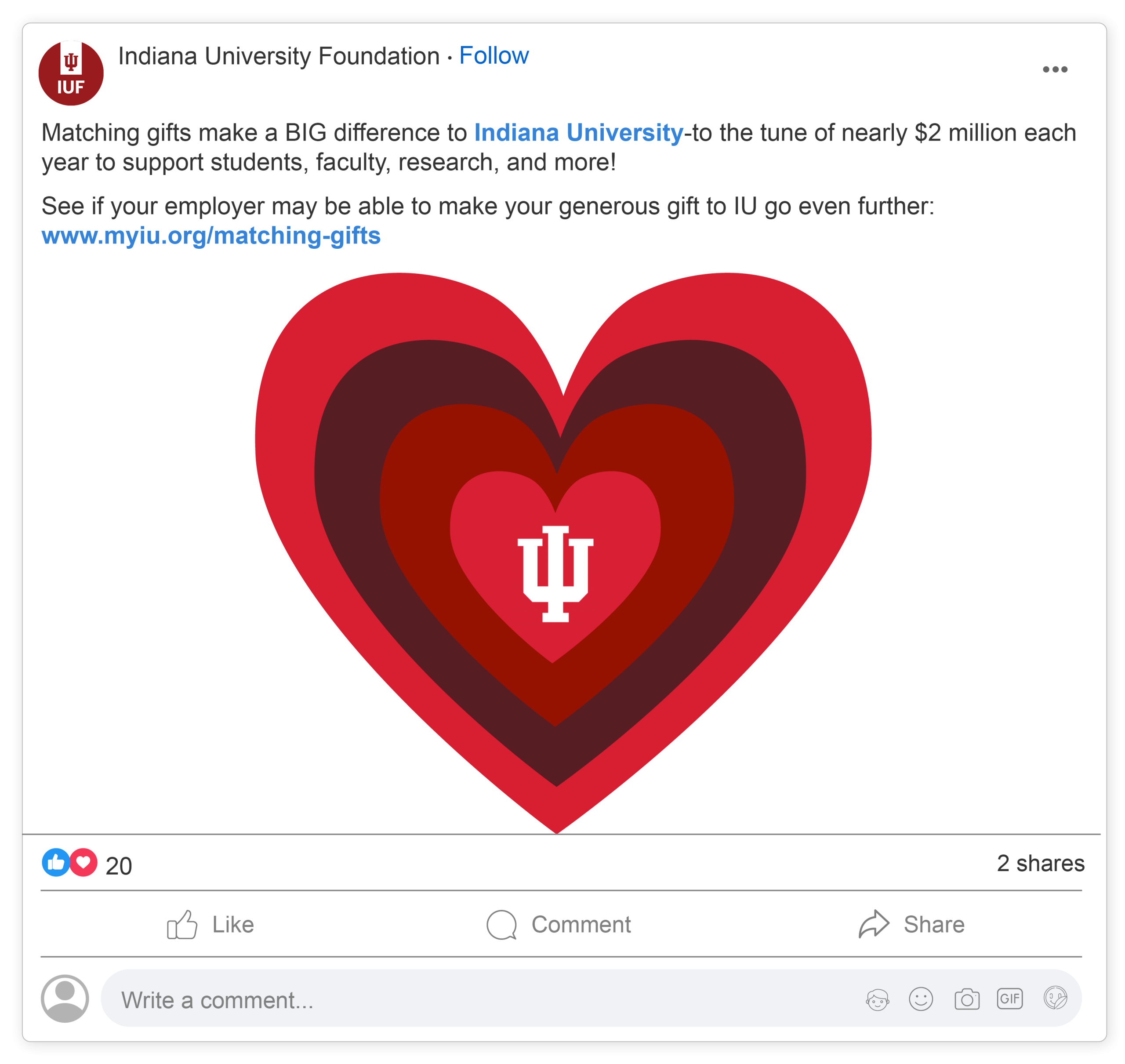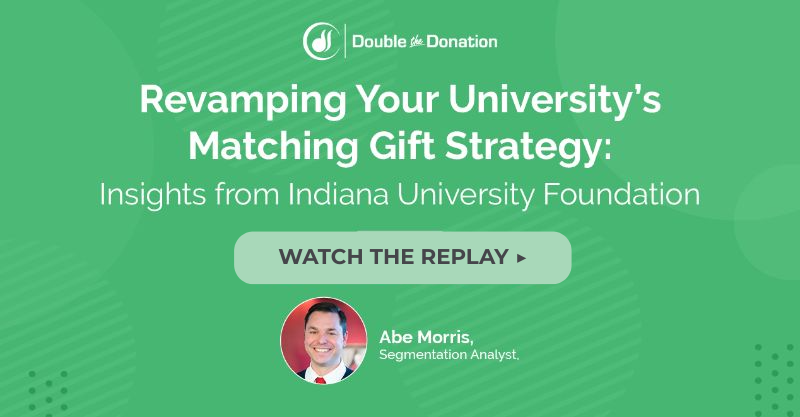Revamp Your University’s Matching Gift Strategy: Tips from IUF
University advancement teams are always looking for ways to increase donor impact and build stronger relationships with alumni and supporters. One of the most effective—but often underused—tools is matching gifts. If you’re looking for ways to revamp your university’s matching gift strategy, you’ve come to the right place.
In a recent webinar, we sat down with Abe Morris, Segmentation Analyst at the Indiana University Foundation (or IUF), to discuss the various ways in which their team optimized its approach to matching gifts—streamlining processes, improving donor engagement, and maximizing revenue. As he spoke, we learned that one of the first items Abe was tasked with, upon beginning his new role at IUF in 2022, was to take a look at their matching gift program and see what he could do to improve it. They started with a single, quarterly piece of direct mail promoting matching gifts, so outreach was infrequent and single-channel, with a lot of room to grow. And grow they did!
Interested in viewing the full presentation? Check out the replay here. Otherwise, let’s walk through an overview of the steps the team took to revamp their university’s matching gift strategy.
Conducting an ROI analysis
The first step in refining the matching gift strategy was a thorough return on investment (ROI) analysis—a critical move to better understand the current state of matching gift participation and identify areas for growth. This analysis involved digging into existing donor data to evaluate key metrics such as:
- The total amount of individual giving
- How much of that giving was being matched by employers
- The completeness and accuracy of employer information in the database
- The match eligibility rate among known donors
Two important insights emerged from this deep dive. First, employer data was often incomplete or missing, making it difficult to identify match-eligible donors. Second, even among donors whose employers were confirmed to offer matching gift programs, many were not submitting match requests. This revealed a significant gap between potential and actual matching gift revenue.
In short, the analysis confirmed that there was untapped potential sitting in the donor base—dollars left on the table simply due to lack of awareness, missing data, or process gaps. By identifying these inefficiencies early on, the team could begin targeting specific opportunities to improve data quality, educate donors, and drive more match requests, ultimately maximizing revenue from matching gifts.
As Sydney Faye from Double the Donation adds, “For a university advancement team, the first step is always to measure what’s missing. The ROI analysis is critical because it reveals the ‘ghost revenue’—the massive amount of matched funds left unclaimed due to missing employer data or donor unawareness. Identifying this gap transforms matching gifts from a passive administrative task into a top-tier revenue driver for the institution.”
Setting goals
To tap into their full matching gift potential, the Indiana University Foundation knew they needed more than just good intentions. What they needed was a clear roadmap. That began with setting three focused, strategic goals designed to guide their efforts and measure success over time.
1. Increase donor awareness of matching gift programs.
IUF recognized that many eligible donors simply weren’t taking advantage of their employer’s matching gift offerings, often because they didn’t know the programs existed.
“One of our primary goals became boosting awareness through targeted outreach, donor education, and timely follow-ups.” – Abe Morris, Segmentation Analyst at the Indiana University Foundation (or IUF)
By embedding matching gift messaging throughout the giving journey—from donation forms to thank-you emails—they aimed to keep the opportunity front and center.
2. Improve the quality and quantity of employment data.
Incomplete or outdated employer information was another major barrier to unlocking matching gifts. Without knowing where donors worked, it was nearly impossible to identify eligible matches.
So IUF set a second goal: to collect and maintain more accurate employment information through methods like donation form fields, email outreach, and more. The more complete their records, the better they could personalize matching gift outreach and follow up effectively.
3. Increase total matching gift revenue.
Ultimately, all efforts were tied to a larger goal: growing matching gift revenue in a sustainable and scalable way. By raising awareness and improving data, IUF positioned itself to capture more matches—and to track the financial impact over time. This goal served as both a measure of success and a motivating benchmark for the entire advancement team.
Together, these three goals created a solid foundation for revamping IUF’s matching gift strategy—turning what was once a passive revenue stream into an active driver of philanthropic growth.
Understanding the matching gift process
Before the Indiana University Foundation could fully execute their matching gift strategy, they needed to deeply understand how the process worked from start to finish. That meant mapping out the actual donor journey and identifying where opportunities were being missed or delayed.
“To do this, we collaborated closely with the revenue operations team, digging into the mechanics of how matching gifts flowed into the organization.” – Abe Morris, Segmentation Analyst at the Indiana University Foundation (or IUF)
This step was critical—not just for optimizing internal workflows, but also for identifying pain points that were impacting both donors and the university’s ability to secure matching funds.
Here’s what they uncovered:
When a donor makes a gift, several things can happen. Sometimes, the donor is already aware of their employer’s matching gift program and initiates a request on their own. In other cases, however, the donor learns about the opportunity through post-donation outreach—like emails, website prompts, or follow-up reminders from the university. At the time, though, the main way the Foundation was communicating was via direct mail, and it would take up to three months for donors to hear about matching gifts.
Once the donor decides to pursue the match, they typically complete an online form through their employer’s portal. This form is then reviewed by their employer, who contacts the institution (in this case, IUF) to verify that the original donation was made and that it meets the company’s matching criteria.
After this verification step, either the employer or a third-party vendor—such as a corporate social responsibility (or CSR) platform—processes the matching payment. The funds are sent to the university and recorded in the advancement system as a matched gift.
This process may sound straightforward, but it involves multiple stakeholders, timing dependencies, and data handoffs. What stood out most in this analysis was the importance of coordination—from clear communication with donors to timely responses to employers, every step plays a role in securing the match. From this, it became clear that they needed faster follow-ups, integrated systems, and more to better guide donors through the matching process.
Becoming familiar with common challenges
With a clear understanding of the matching gift process in hand, the next critical step for the Indiana University Foundation was to confront the realities of implementation—specifically, the common challenges that can hinder matching gift success. Anticipating these hurdles allowed the team to build a more resilient and responsive strategy.
“Some of the biggest challenges include the irregularity of matching gift disbursements, limited visibility into matching gift fulfillment, and company-specific restrictions on match eligibility.” – Abe Morris, Segmentation Analyst at the Indiana University Foundation (or IUF)
Luckily, by proactively identifying these common challenges, IUF was able to manage expectations, educate donors more effectively, and fine-tune internal systems to catch and respond to issues before they became roadblocks. In other words, understanding the obstacles up front laid the groundwork for a more strategic and sustainable matching gift program moving forward.
Making the most of employer data
Once the IUF had a clearer picture of the challenges surrounding matching gifts, the next step was to optimize the data they already had—specifically, employer information. This required a close partnership with the advancement data team to figure out how to better collect, manage, and activate that data in ways that would directly support matching gift efforts.
The first major improvement was integrating Double the Donation’s matching gift tool into the university’s website and donation forms.
This solution allows donors to easily search for their employer during the giving process and instantly discover if they’re eligible for a matching gift program. With the tool embedded directly at the point of donation, IUF could proactively surface relevant matching gift information in real time, instead of relying on delayed outreach months later.
Establishing a matching gift communication plan
With the right tools and data in place, the Indiana University Foundation turned its attention to an equally critical component of a successful matching gift strategy: communication. The Foundation knew that simply having the information wasn’t enough. They needed to ensure it reached the right people at the right time, in a way that felt helpful rather than overwhelming.
To accomplish this, IUF began to weave matching gift language into nearly every relevant donor touchpoint. They integrated it across their communications ecosystem—from gift receipts and email follow-ups to donation forms and social media ads.
Each message was crafted with purpose and clarity, pointing donors to the university’s dedicated matching gifts page for more information.
By establishing a comprehensive, multi-channel communication plan, IUF increased visibility for matching gifts, reinforced donor education, and significantly improved the likelihood that eligible supporters would follow through. It wasn’t just about raising awareness—it was about creating a consistent, donor-friendly experience that made taking action feel seamless.
As Sydney Faye from Double the Donation expounds, “The communication plan for matching gifts needs to be omnipresent but not repetitive. Every touchpoint—the confirmation email, the website, the social media post—should feature the matching gift opportunity. This multi-channel reinforcement ensures that no matter where the donor is or how they prefer to interact, they encounter the matching prompt, making it impossible to overlook the chance to double their gift.”
Measuring and tracking success
With new systems, tools, and strategies in place, IUF knew that ongoing success would hinge on one key factor: measurement. If they couldn’t track the impact of their efforts, they couldn’t improve them or demonstrate their value to stakeholders.
To close that loop, the team prioritized building a dedicated matching gift performance dashboard. This internal tool was designed to monitor real-time data and offer a clear view of progress toward their strategic goals.
The dashboard focused on a few core metrics:
- Total matching gift revenue — to measure the overall financial impact
- Number of matching gifts received — to gauge engagement and donor participation
- Percentage of eligible donors who submitted matches — to assess the effectiveness of outreach and education
By comparing KPIs over time, IUF could clearly see which initiatives were working and where there was room to grow. Just as importantly, they were able to tie these insights back to their original goals. Increasing donor awareness, improving data quality, and maximizing matching gift revenue.
Frequently Asked Questions (FAQ)
1. Why is a strong matching gift strategy essential for universities?
A strong matching gift strategy helps universities unlock substantial corporate funding by encouraging alumni and donors to submit employer match requests. This increases overall giving, boosts alumni engagement, and ensures institutions capture revenue that often goes unclaimed.
2. How can universities increase donor awareness of matching gift programs?
Universities can increase awareness by adding matching gift reminders to their giving pages, alumni newsletters, social media campaigns, and donation confirmations. Providing an employer search tool during the donation process greatly improves match submission rates.
3. What common challenges do universities face with matching gifts?
Universities often struggle with incomplete employer data, low donor awareness, and inconsistent follow-up workflows. These gaps lead to missed matching gift opportunities, making data accuracy, improved communication, and automated outreach essential.
4. How can universities build an effective matching gift strategy?
Universities can build an effective matching gift strategy by integrating matching gift tools into donation forms, educating donors about employer match programs, and sending automated follow-ups. A clearly defined process ensures no eligible match goes unnoticed.
5. What tools can universities use to streamline matching gift outreach and tracking?
Automation platforms such as Double the Donation helps identify eligible donors, send personalized reminders, and track match status in real time. These tools reduce manual work and significantly increase completed matching gift submissions.
Wrapping up & webinar replay
Matching gifts represent a major opportunity for universities—but only if you have the right strategy in place. Success starts with donor education, efficient verification workflows, and strong collaboration between advancement teams and corporate partners.
By applying these lessons, your university can transform matching gifts from a passive afterthought into a powerful fundraising engine. Start small, stay consistent, and watch your impact multiply.








